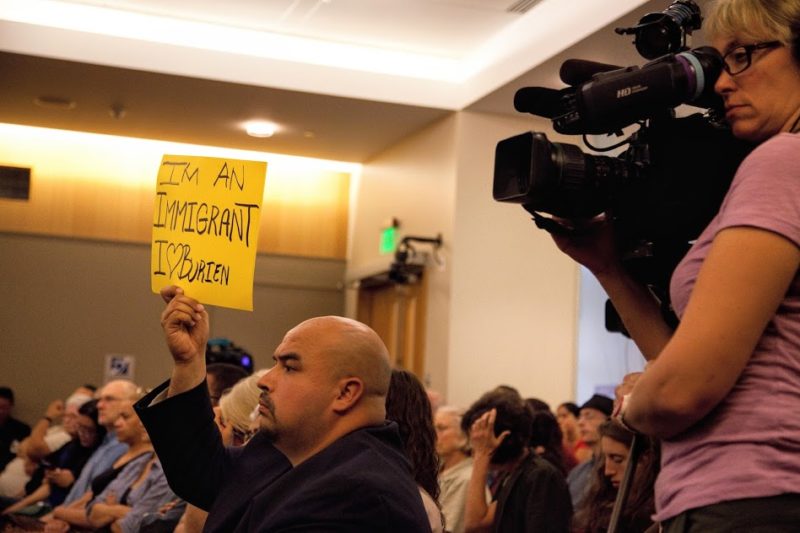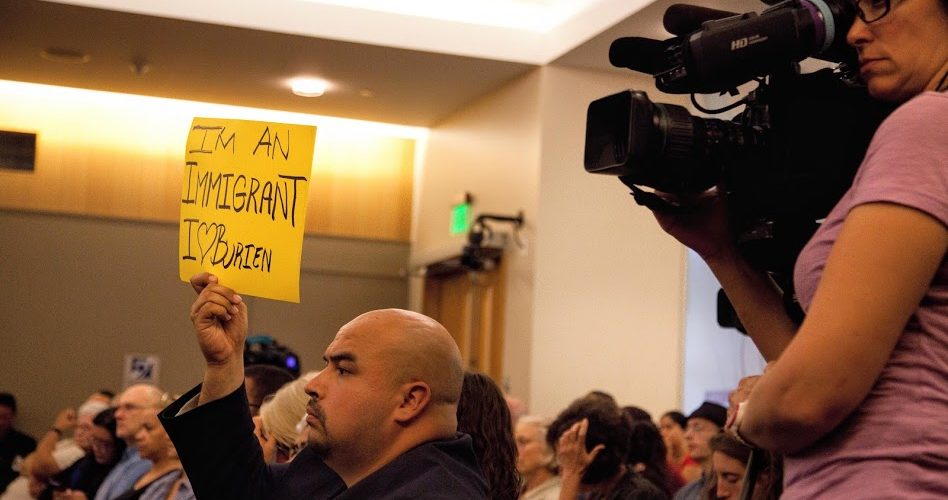Sign up for The Media Today, CJR’s daily newsletter.
BURIEN, A SUBURB OF SEATTLE, is not known for holding raucous city council meetings. But on July 31, opposing activist groups squared off in City Hall over a proposition to repeal Burien’s “safe city” status, a sanctuary ordinance prohibiting city employees and police from asking people about their citizenship status.
During the public comments session, a row broke out between the two groups. Members of the pro-sanctuary group “Burien Represent” recorded each other with their smartphones while chanting: “Whose city? Our city! Whose streets? Our streets!” Craig Keller, leader of the anti-sanctuary group “Respect Washington,” aimed a tripod-mounted camcorder at them. (Keller’s footage later aired on Fox News.) Standing on the periphery, a reporter for the Seattle-based alt-weekly The Stranger, Sydney Brownstone, recorded a series of short videos she posted on Twitter.
https://twitter.com/sydbrownstone/status/892243398957989888
The mayor ordered the sheriff to clear the meeting room. After a stern talking-to, the activists were allowed back into City Hall.
The episode underscores a reality for Seattle journalists reporting on immigration in their sanctuary city: the most important news often takes place in the suburbs.
A reporter called Seattle’s suburbs ‘the frontline for conflicts over immigration. As reporters, we have to get better at reporting in them, which is difficult because most of us live in the city.’
A booming economy has created a housing shortage in Seattle, pushing up real estate prices. Over the past decade, working class residents, many of them minorities and first-generation immigrants, have left the city to find more affordable housing in suburbs like Burien, Kent, and SeaTac. An interactive map published by Governing Magazine shows that Burien borders a cluster of suburban municipalities hit hard by Seattle’s gentrification.
A demographic shift is affecting Burien, where the Hispanic population has grown from 10 percent, in 2000 to 24 percent in the most recent census. That change has yet to be reflected in the ethnicity of the Burien city council, which is all white.
“Ethnoburbs have been pretty well documented for several years now,” says Brownstone, who’s been with The Stranger for nearly three years, and previously worked for Mother Jones, The Village Voice, and others. “In Trump’s America, they’re the frontline for conflicts over immigration. As reporters, we have to get better at reporting in them, which is difficult because most of us live in the city.”

Photo by Ryan Bell
Seattle has figured prominently in the country’s immigration debate, with locally reported stories gaining national attention. After President Trump’s election in November 2016, Seattle was among the first to declare itself a sanctuary city in response to Trump’s vow to crack down on cities harboring undocumented immigrants. In February 2017, Washington Attorney General Bob Ferguson blocked President Trump’s first travel ban. Also that month, news broke that Immigration and Customs Enforcement (ICE) officials had arrested Daniel Ramirez Medina, a “Dreamer” legally residing in the Seattle suburb of Des Moines as an enrollee of the Deferred Action for Childhood Arrivals (DACA) program.
Brownstone, a Seattle resident, says it’s difficult to stay on top of breaking news stories in the suburbs. She learned about the sanctuary-repeal proposition thanks to The B-Town Blog, a hyper-local news source published by South King Media. The blog’s senior writer, Jack Mayne, is a former city editor for the Seattle Post-Intelligencer.
“I’m a retired daily newspaper editor that got bored,” Mayne says. “Retired means dead, so I decided to keep on working.”
In addition to editing B-Town, Mayne writes for the website’s sister publication, The Waterland Blog, which covers the suburb of Des Moines. On that website, he helped break the news that ICE had falsified its case against Daniel Ramirez Medina.
Even those immigrants who do speak English can be reluctant to give interviews because of the threat posed by ICE roundups.
With over 40 years of experience reporting in the greater Seattle area, Mayne has a long list of contacts in government and police departments. But even the deepest Rolodex can’t help him overcome language and cultural barriers that make it difficult to gain access to sources in the immigrant community. Brownstone, who also does not speak Spanish, finds that even those immigrants who do speak English can be reluctant to give interviews because of the threat posed by ICE roundups.
Matt Adams, legal director for the Northwest Immigrants Rights Project, says that an immigrant’s willingness to speak to the press depends on a number of considerations.
“Sometimes our clients want everybody to know what has happened to them and are willing to use their names, pictures or even provide interviews on television,” Adams writes in an email. “Other times, as examples, clients don’t want their boss to know they are having problems with immigration, or don’t want their community to know that they have filed a lawsuit against the government because they worry someone will think they are going to get a lot of money and that might make them or their family a target.”
Liz Jones, a reporter and radio host for KUOW, Seattle’s NPR affiliate, has relied on her knowledge of Spanish to gain unprecedented access to Seattle’s hispanic community. She’s one of the few reporters to have been granted a visit to the Tacoma Northwest Detention Center, a facility that holds ICE detainees. There, she reported the story of a detained woman who suffered a miscarriage while incarcerated, raising questions about prenatal health care for detainees.
“I’ve been an immigration reporter for seven years,” Jones says, “so I have a good relationship with a lot of the attorneys who work in immigration law. A lot of my immigrant contacts come through attorneys, and that helps build trust between the detainees and myself.”
At the Burien City Council meeting in July, the clocked ticked past 10:30pm. One council member, exasperated that her colleagues kept extending the discussion period, said: “This is a business meeting, not a pajama party.” They agreed to adjourn the meeting, postponing a vote on the proposition until the following week.
By that time, news had spread and Burien City Hall was packed, with overflow seating in the lobby. The mayor laid down rules to keep the crowd orderly: no cheering, chanting, or applause. After hearing more public comments, the council members voted in favor of putting the proposition on the November ballot, handing the decision about the fate of Burien’s sanctuary status to the voters.
Has America ever needed a media defender more than now? Help us by joining CJR today.



